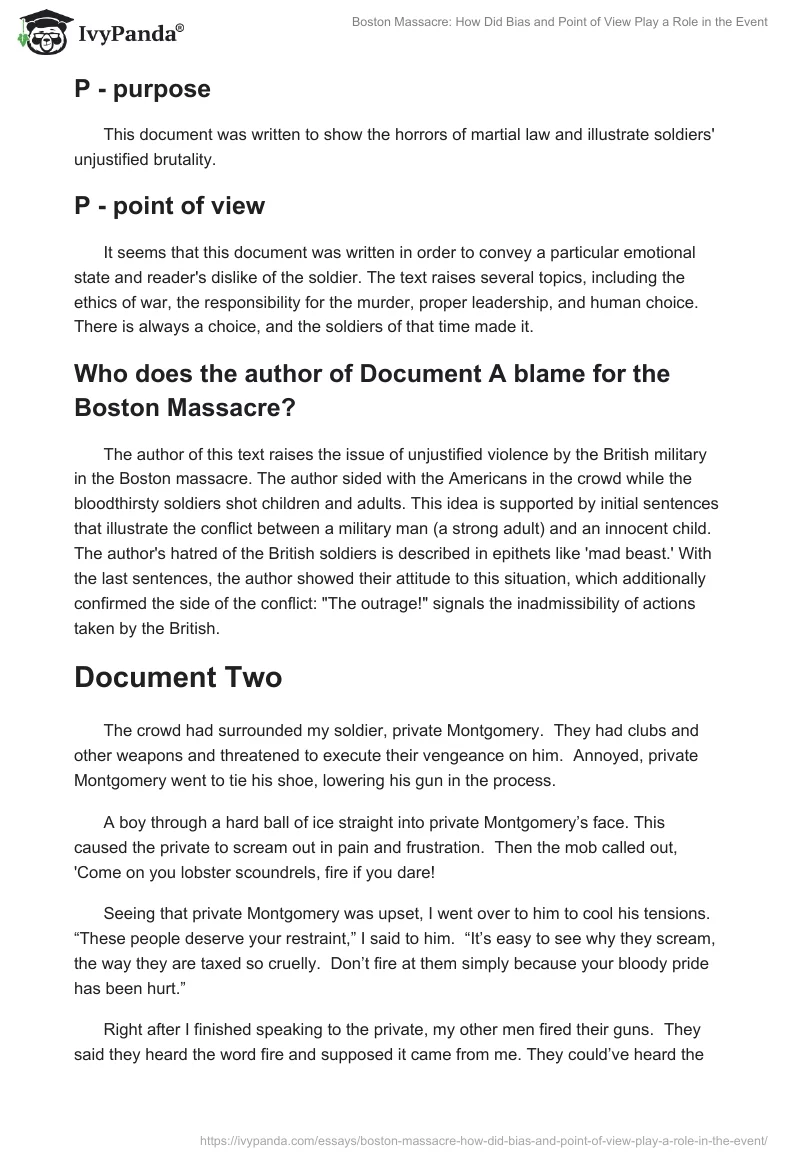Document One
I saw the private (low ranking soldier), Montgomery, lower his gun at a child with a nasty look on his face. He was ready to kill, I can tell you that.
One of the boys in the crowd threw a snowball at private Montgomery, giggling in innocence. The private cursed back at him in anger like some mad beast. The crowd screamed back in response, as is natural.
The Captain, Captain Preston, walked over to private Montgomery, screaming something in his ear as he pointed to the American crowd. From what I could hear, he said “they deserve…” and then “your bloody pride.” If you ask me, he was saying the private should fire on the crowd to keep his pride.
Captain Preston screamed “fire!” and his men shot into the crowd. Five were killed. The outrage!
H – historical context
Some things happening at that time were a completely natural phenomenon for the environment. For example, the shooting of a crowd could be justified by martial law and hostility between the parties (although from an ethical point of view, such actions could not be justified).
I – Intended audience
The document was supposedly written for non-professional readers to familiarize themselves with history. The emotional component of the story subjectivates the author’s side and causes certain feelings in the reader. This text is well suited for school students.
P – purpose
This document was written to show the horrors of martial law and illustrate soldiers’ unjustified brutality.
P – point of view
It seems that this document was written in order to convey a particular emotional state and reader’s dislike of the soldier. The text raises several topics, including the ethics of war, the responsibility for the murder, proper leadership, and human choice. There is always a choice, and the soldiers of that time made it.
Who does the author of Document A blame for the Boston Massacre?
The author of this text raises the issue of unjustified violence by the British military in the Boston massacre. The author sided with the Americans in the crowd while the bloodthirsty soldiers shot children and adults. This idea is supported by initial sentences that illustrate the conflict between a military man (a strong adult) and an innocent child. The author’s hatred of the British soldiers is described in epithets like ‘mad beast.’ With the last sentences, the author showed their attitude to this situation, which additionally confirmed the side of the conflict: “The outrage!” signals the inadmissibility of actions taken by the British.
Document Two
The crowd had surrounded my soldier, private Montgomery. They had clubs and other weapons and threatened to execute their vengeance on him. Annoyed, private Montgomery went to tie his shoe, lowering his gun in the process.
A boy through a hard ball of ice straight into private Montgomery’s face. This caused the private to scream out in pain and frustration. Then the mob called out, ‘Come on you lobster scoundrels, fire if you dare!
Seeing that private Montgomery was upset, I went over to him to cool his tensions. “These people deserve your restraint,” I said to him. “It’s easy to see why they scream, the way they are taxed so cruelly. Don’t fire at them simply because your bloody pride has been hurt.”
Right after I finished speaking to the private, my other men fired their guns. They said they heard the word fire and supposed it came from me. They could’ve heard the word “fire,” as many of the mob called out fire, fire, but I assured the men that I gave no such order; that my words were, don’t fire, stop your firing….
H – historical context
Really confusing. The British soldiers remained human and hardly intended to kill the Americans. However, the British in Boston were clearly hostile to the citizens, and any action could be considered as provocation.
I – Intended audience
This text was written for supporters of English imperialism and professional history lovers who want to understand the subtleties of the tragedy. For students, this text is a good illustration of the ambiguity of many actions and the error of a cursory judgment..
P – purpose
This text was made to show the reverse side of the Boston Massacre. The purpose was to reflect the opinion of British soldiers: to show their compassion and empathy. Coupled with the previous one, this text expands the horizons of the tragedy.
P – point of view
This document was written by the author in order to exhibit a broader picture of what happened. The text raises several topics, including the price of the misperception of information, the problem of soldiers in the war, remorse, hatred from the crowd.
Who does the author of Document B blame for the Boston Massacre?
Interestingly, there is no specific guilty party in this document. In particular, one can blame the Case, the crowd, or the Commander who has not thought about his own words: but it makes no sense. By chance, the words of the Captain were misinterpreted by the soldiers, which caused the killings. However, the author takes the British side since the text begins with the words that the surrounded soldier was “my.” In this story, the soldiers are described as innocent performers of political leaders who do not want to kill and are able to endure personal resentment. Meanwhile, the last sentence of the text sounds like the Commander’s excuse, so it is possible that the text was written from the Captain’s words.


